Kaj Halberg - writer & photographer
Travels ‐ Landscapes ‐ Wildlife ‐ People
Hunting dogs – nomads of the savanna
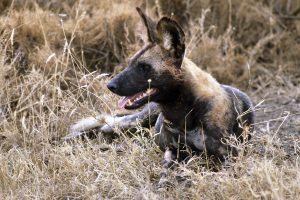
The poor hyaena zoomed across the savanna, bleeding from its behind and legs, still chased by the furious dogs. Finally, the hyaena backed into a hole, where only its head and front paws were exposed, and from this position, its powerful jaws could keep the dogs at bay. The dogs left, returning to their territory, where two other hyaenas received the same type of punishment, which made them retreat quickly.
Hyaenas are much attracted to hunting dogs, as the dogs’ faeces is one of their favourite foods, which they are willing to do almost anything to get at. There have been instances of hyaenas, which crept up to a sleeping hunting dog to lick its anus, with the risk of being bitten in their behind. Hyaenas also often try to steal prey from hunting dogs, and if their pack is large enough, they may succeed in chasing away the dogs from their prey.

This was also the case with this gazelle, and the hunt ended abruptly after only two minutes, when one of the dogs caught up with the buck. The collision between them was so violent that the buck literally made a somersault. A few seconds later, the dogs had a firm grip at it, their sharp teeth tearing open the belly of the gazelle, which was still alive, when the dogs began gorging themselves on the intestines.
“Hang on!” shouted our driver Moses, racing like a madman across the bumpy savanna at 70 km/hour. We reached the dogs, shortly after they had commenced eating. They ignored the car completely. The gazelle died after a minute or so, and ten minutes later it had been devoured, with only the head, some bones, and a few bits of skin left behind. As a gazelle buck weighs around 60 kilograms, each of the four dogs had eaten ten to twelve kilograms of meat!

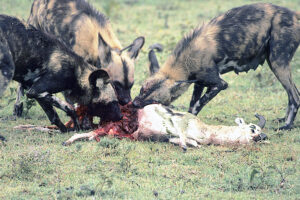

Nine pups, about four weeks old, with black, wrinkled faces and enormous ears, emerged from the den, tottering about on their short legs. They surrounded the bitch, licking the corners of her mouth. She retreated a bit, making a few convulsive throat movements, and proceeded to regurgitate a large portion of meat. The pups at once fell upon it, swallowing the smaller bits and fighting over the larger ones, which, in some cases, evolved into a tug-of-war.
When the other three dogs returned to the den, they also regurgitated meat, not only for the pups, but also for the mother and for the fifth dog, which had remained at the den to guard the pups.
All dogs in a pack participate in the upbringing of a litter. When the pups are very young, the mother, and often also another dog, will remain at the den, while the other members of the pack are out hunting. Even if the mother dies, the other members of the pack will rear the pups. There was even an example of a pack of male dogs rearing a litter of pups, when the mother – which was the only female in the pack – had died.
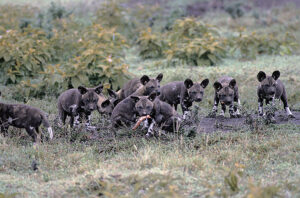

Formerly, not much was known about the social structure and habits of the hunting dog, and people had many prejudices against them. Watching their violent way of killing and eating their prey alive is a rather nasty spectacle, and many people hated them, regarding them as evil murderers. Farmers shot them on sight, and even in national parks they were persecuted. Soon they were eradicated over large parts of their former distribution area.
The truth of the matter is that this method of killing is quick and efficient. Large and deep wounds cause an instant shock effect, and the sufferings of the prey are probably rather limited, before it dies, which mostly happens within a few minutes. Larger prey like zebras (Equus quagga) and wildebeest (Connochaetes taurinus) may live a little longer. Up to 17 minutes has been recorded, but such cases are very rare.
Generally, people seem to have a much more sympathetic attitude towards the way that large cats kill their prey, namely by strangling it with a firm grip around the neck. This is not a very bloody affair, which is probably why people regard it as more ’humane’. In reality, the prey is suffering for a much longer time by being strangled than by being torn apart alive.
Hunting dogs live in packs, the size of which varies tremendously, from 2 to about 25 members, mostly between 6 and 10. For the major part of the year, these animals are nomads, roaming savannas and woodlands in search of prey. British explorer Wilfred Thesiger (1910-2003) once encountered a pack far up the slopes of Kilimanjaro.
The hunting area of a pack may surpass 4,000 km2. The areas of two packs sometimes overlap, and territorial fights have been observed. In most cases, however, one of the packs will retreat to avoid a fight.
The main prey of hunting dogs are smaller animals like gazelles and warthogs (Phacochoerus africanus), but they occasionally hunt larger prey like wildebeest. One pack in the Serengeti National Park had specialized in killing zebras. One of the pursuing dogs would attach itself to the zebra’s tail, causing it to stop and bite at the dog. Another dog would then jump up and attach itself to the zebra’s soft muzzle and, for some reason or other, this action would paralyze the zebra, which would stand dead-still, while the remaining dogs tore open its belly, causing the intestines to fall out. Far from all zebra hunts, however, would end in this way. A herd of zebras comprises mares with their foals, guarded by a stallion, which is very brave when defending his herd. In most cases, the stallion is able to drive away the dogs by kicking and biting.
Formerly, it was generally believed that once the dogs had chosen a prey it was doomed. This is a myth, as less than half of their hunts are successful. The dogs are able to run at 60 km/hour, whereas gazelles, over shorter stretches, can run at almost 80 km/hour. This is why the dogs spend a considerable time watching a flock of gazelles to pick out the weakest animal. Another method is to split into smaller hunting units, which co-operate to cut off a member of the flock.
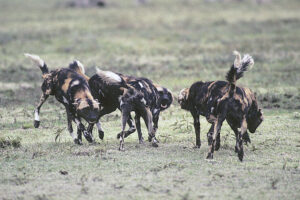
Hunting mainly takes place in the morning and in the evening, whereas the hottest part of the day is spent resting and sleeping, often in the shade beneath a tree. Occasionally, a dog or two will wake up, uttering a twittering call, which makes all members of the pack run around among each other, whining and wagging their tail, while licking one another’s faces. This greeting ceremony, which is derived from food-begging, strengthens the solidarity of the pack and will also subdue aggression in the dominant animals. This is a necessity during a hunt, where it is essential not to waste energy on submission postures. In fact, prey is killed by low-range members just as often as by dominant dogs.
Researchers believe that most male dogs stay in a pack after reaching adulthood, whereas females leave the pack to join other groups – a means to prevent inbreeding. Thus, most males in a pack are brothers or half-brothers, and research has shown that aggression is far more frequent among females than among males.

The pack is now sedentary for some months, while the pups grow up. Before giving birth, the pregnant bitch enters ‘false heat’, which means that she secretes the same type of hormones as during the genuine heat, causing the male dogs to remain in the area instead of continuing their nomadic way of life. The dominant female marks the surrounding savanna with urine, announcing to other packs that this particular area is occupied.
As a rule, a bitch gives birth to between 8 and 16 pups. She only has 12 or 14 teats, and in larger litters the pups must suckle in turn. Under normal circumstances, the other dogs in the pack have no difficulty in supplying enough food for the mother and her pups. During his studies, van Lawick noticed a peculiar behaviour of a dominant female, suckling a mother dog of a lower status. The desire for suckling seems to be quite strong.
Usually, hunting dogs have no fear of other animals – on the contrary, most other animals are afraid of the dogs. However, when they have pups, the dogs are very nervous of the presence of lions, and in such cases, they often move the pups to another den.
When pups are about two months old, they start joining the adults during the initial part of their hunting trips, but quickly return to the den. As time goes by, they get bolder, and at an age of about three months, they are ready to join the adults on their wanderings. When the pups participate in a hunt, they are allowed to eat first, even if they didn’t take part in the killing proper.
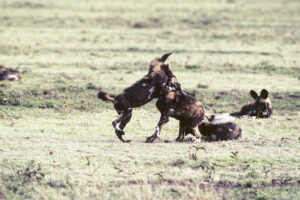
This pack resumed their nomadic way of life, when the pups of the dominant female were about three months old. Little Solo tried her best to keep up with the pack, but, as days went by, she got ever more exhausted. At last, the pack left her, and the researchers brought her back to their camp.
Some days later, they encountered two hunting dogs, which had left their pack – a pair with pups, which were somewhat younger than Solo, but about the same size, as Solo had never had enough food to grow normally.
The scientists now placed a cage, containing Solo, near the dogs’ den, anxiously awaiting what would happen. As it turned out, the two dogs got very interested and approached the cage, sniffing the small prisoner. When the cage was opened, Solo ran out, performing the various submission postures, and, what the researchers had hoped for, happened: The dogs accepted Solo, and the female let her suckle alongside her own pups.
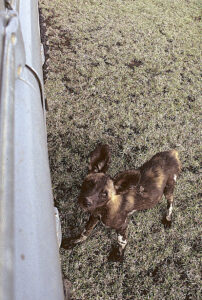
Hopefully, these fascinating nomads will continue to roam the African savannas in the future.

